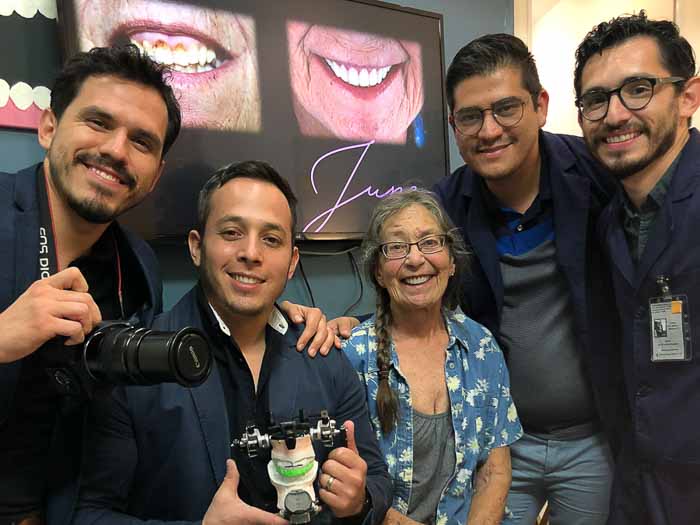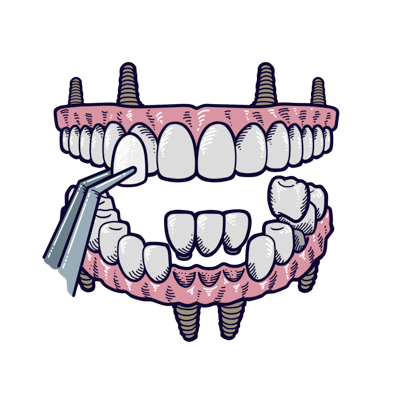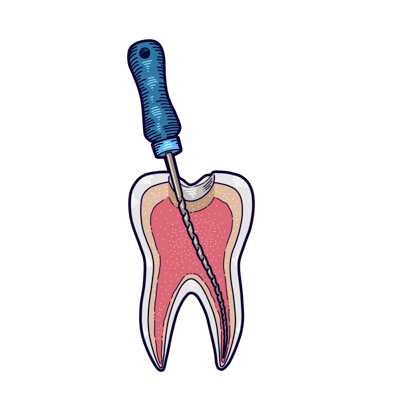Price of
IMPLANT
SUPPORTED
BRIDGES
IN MEXICO

Try our Cost & Smile Simulator
from the comfort of your own home.
100% Free. 100% Confidential.


Introduction
In this guide, we’ll explore the details of implant supported bridges in Mexico, focusing on their price, procedure, and how they integrate with the All on 4 system. If you are a patient seeking a full-mouth solution, read on to see why implant supported bridges might be the right choice for your All on 4 treatment plan.
What Are Implant Supported Bridges?
How Implant Supported Bridges Relate to the All on 4 Procedure
What is the relationship between the All on 4 procedure and implant supported bridges?
The All on 4 treatment concept is a specific type of implant supported bridge that uses only four implants to support a full-arch prosthesis. This approach is designed to optimize the number and placement of implants, making it more cost-effective and minimally invasive compared to traditional methods. While a conventional full-arch restoration might require 6 to 8 implants, the All on 4 technique strategically places just four implants to evenly distribute the load of the entire prosthesis.
For patients missing most or all of their teeth, the All on 4 treatment offers an innovative way to achieve a complete smile using fewer implants while still providing the stability and aesthetic benefits of a traditional implant supported bridge.

Can All on 4 and implant supported bridges be combined?
Yes, combining these treatments is common. For example, a patient may have a segmental implant supported bridge on their upper arch but require a full-arch All on 4 prosthesis on the lower arch due to different levels of bone density or oral health conditions. Understanding how these two solutions complement each other is key to creating a tailored treatment plan that meets the unique needs of each patient.
Why Do All on 4 Patients Consider Implant Supported Bridges?
Why should All on 4 patients consider implant supported bridges as part of their treatment plan?
All on 4 patients often consider implant supported bridges when they need a more tailored approach that balances full-arch stability with targeted tooth replacement. For instance, some patients may not require a complete full-arch replacement but still need a stable and long-lasting solution for multiple missing teeth in a row. An implant supported bridge can address these specific needs while preserving the integrity of the remaining healthy teeth.
Additionally, implant supported bridges are sometimes used as a transitional solution. If a patient does not have sufficient bone density for an immediate All on 4 placement, a staged treatment involving implant supported bridges can help build up bone quality before transitioning to a full-arch All on 4 prosthesis.
Significant Price Savings
All on 4 implants in Mexico are priced up to 60% lower compared to the USA and Canada, without compromising on quality.
Access to Experienced Professionals
Mexico is home to highly skilled dentists who specialize in implant dentistry, many of whom have received training in the USA or Europe.
State-of-the-Art Facilities
Dental clinics in Mexico are equipped with modern technology and adhere to international sterilization standards. 6


Try our online Cost & Smile Simulator from the comfort of your own home.
100% Free. 100% Confidential.
Price of Implant Supported
Bridges in Mexico
What is the average price of implant supported bridges in Mexico?
The price of implant supported bridges in Mexico is significantly lower compared to the USA and Canada, making it a popular option for dental tourists. Typical price ranges include:
Single Implant with Crown
$1,400 USD to $1,600 USD per implant.
3-Unit Implant Supported Bridge
$3,200 USD to $4,000 USD.
Full Arch All on 4 Bridge
$8,000 USD to $12,000 USD per arch.
The All on 4 configuration tends to be more affordable as it requires fewer implants, making it the preferred option for patients seeking full-mouth restorations at a lower price point.
Comparing Prices:
Mexico vs. USA and Canada
How do prices for implant supported bridges compare between Mexico and North America?
| Procedure | Mexico | USA | Canada |
|---|---|---|---|
| Single Implant with Crown | $1,500 USD | $4,000 USD | $4,500 USD |
| 3-Unit Implant-Supported Bridge | $3,200 USD | $8,000 USD | $9,000 USD |
| Full Arch All-on-4 Bridge | $8,000 USD | $25,000 USD | $28,000 USD |
This price comparison shows that choosing Mexico for implant supported bridges can result in up to 60% savings without sacrificing quality or safety.

The All on 4 Procedure Explained
The All on 4 procedure is a comprehensive solution designed to replace a full arch of teeth using only four implants. The process is straightforward but requires a high degree of skill and precision. Here’s a detailed step-by-step breakdown of the treatment:
Q: What happens during the initial consultation for an implant supported bridge or All on 4 treatment?
During the initial consultation, the dentist will conduct a comprehensive evaluation of your oral health. This involves a thorough dental examination, digital imaging (such as panoramic X-rays or 3D CBCT scans), and a review of your medical history. The goal is to determine the health of your gums, bone density, and the positioning of any remaining teeth to ensure that the implants can be placed in optimal locations.
For All on 4 patients, this initial assessment is crucial because the treatment is designed to avoid extensive bone grafting. By examining the bone structure, the dentist can plan for the strategic placement of the four implants that will support the entire prosthesis. In contrast, if a patient opts for a conventional implant supported bridge, more implants might be recommended based on the number of teeth being replaced.
Q: How is a customized treatment plan created for each patient?
After the diagnostic stage, the dentist will outline a personalized treatment plan. This plan will specify the number of implants needed, the type of bridge material (porcelain, zirconia, or hybrid acrylic), and whether additional procedures like extractions, sinus lifts, or bone grafting are necessary. For All on 4 candidates, the treatment plan will focus on the four-implant configuration, identifying ideal sites for implant placement to ensure optimal support and distribution of the prosthesis.
The treatment plan is a key document, serving as the roadmap for your journey to a fully restored smile. It also allows the patient to discuss the expected price, timeline, and any logistical considerations, such as travel arrangements if you are coming from abroad.
Q: What preparatory steps are taken before implant placement?
Before the surgery, patients may need to undergo preliminary treatments to optimize their oral health. This may include:
- Oral Hygiene Optimization: Deep cleaning to eliminate any infection or inflammation in the gums.
- Extraction of Damaged Teeth: If there are remaining teeth that are unsalvageable, they will be removed to make space for the implants.
- Bone Grafting or Sinus Lifts: While All on 4 is often chosen to avoid bone grafting 8, some patients may still require minor bone augmentation to achieve proper implant stability. This step is more common in conventional implant supported bridges, which often require more robust bone support.
The pre-operative phase is also when the patient will receive detailed instructions on diet, medications, and post-operative care to ensure the surgery and recovery proceed smoothly.
Q: What happens during the implant placement surgery?
The implant placement is a critical step, whether you’re getting an All on 4 or a traditional implant supported bridge. 9 The procedure typically involves the following stages:
- Anesthesia and Sedation: Local anesthesia, and in some cases, IV sedation, is administered to ensure patient comfort.
- Incision and Flap Creation: The surgeon will make small incisions in the gums to expose the underlying bone.
- Implant Placement: Titanium implants are carefully placed into the jawbone. For All on 4, two implants are positioned vertically at the front, while the two posterior implants are angled to maximize bone contact and support. This angled placement is what makes the All on 4 unique, allowing for fewer implants and less invasive surgery.
- Healing Caps or Temporary Bridge: After the implants are placed, healing caps are secured over them, or a temporary bridge may be fitted for immediate aesthetics.
Q: Is the All on 4 procedure faster than traditional implant supported bridge placement?
Yes, one of the key advantages of the All on 4 is that it often allows for same-day placement of a temporary prosthesis. This means patients can leave the clinic with a functional set of teeth on the same day as surgery. In contrast, traditional implant-supported bridges may require a healing period of 3 to 6 months before the final prosthesis is attached.
Q: What is osseointegration, and why is it important?
Osseointegration is the process by which the titanium implants fuse with the surrounding bone tissue, creating a stable and permanent anchor for the bridge. This phase typically takes 3 to 6 months, depending on the patient’s bone quality and overall health.
For All on 4 patients, osseointegration is crucial because the entire arch of teeth relies on just four implants. A stable and successful osseointegration ensures that the final prosthesis will be durable and able to withstand the forces of chewing and biting without risk of loosening or failure.
During this healing period, patients may be instructed to follow a soft diet and attend regular follow-up appointments to monitor the progress of osseointegration.
Q: What are abutments, and how do they fit into the procedure?
Abutments are small connectors that attach the prosthetic bridge to the implants. After osseointegration is complete, a minor second surgery may be required to expose the implant heads and place the abutments. In many All on 4 cases, however, abutments can be pre-attached during the initial surgery, eliminating the need for a second procedure.
Q: How is the final bridge fabricated and placed?
Once the abutments are in place, the dentist will take detailed impressions of your mouth. These impressions are used to fabricate a custom bridge that matches the color, shape, and size of your natural teeth. For All on 4 treatments, a full-arch prosthesis is created, designed to cover the entire span of the upper or lower jaw. The bridge is then secured onto the abutments, and adjustments are made to ensure a comfortable bite and fit.
Q: What post-operative care is required for implant supported bridges?
Proper care is essential to prolong the lifespan of your implants and bridge. Patients should maintain excellent oral hygiene, including brushing twice daily and using interdental brushes to clean around the implants. Regular check-ups are also necessary to monitor the health of the surrounding gums and bone.
Frequently Asked Questions
Is the All on 4 procedure painful?
The surgery is performed under anesthesia, which minimizes discomfort during the procedure. Post-operative pain is typically managed with prescribed medications, and most patients report only mild to moderate soreness for the first few days.
How long does the All on 4 procedure take?
The surgical phase, including implant placement and attachment of the temporary prosthesis, can be completed in a single day. However, the entire process—from initial consultation to final prosthesis placement—may take several months.
What is the success rate of All on 4 implants?
How do I care for my All on 4 implants?
All on 4 implants require the same care as natural teeth. Brush twice daily, use a water flosser or interdental brushes, and visit your dentist for regular cleanings and check-ups.
Can I get All on 4 implants if I have periodontal disease?
Will my new teeth look natural?
Yes, the prosthetic teeth are custom-designed to match the shape, size, and color of natural teeth. Zirconia and porcelain options offer the most natural appearance, closely mimicking the translucency and texture of real enamel.
Tips for Traveling to Mexico for Dental Work

Check for Language Compatibility: Opt for clinics with English-speaking staff to facilitate clear communication.
Verify Licenses and Certifications: Check if the clinic and dentist have international certifications, such as from the American Dental Association (ADA) or Global Clinic Rating (GCR).
Plan Your Stay: Allow for recovery time and possible follow-up visits before returning home.
Understand the Legalities: Research patient rights and the legal framework for medical tourism in Mexico.

Conclusion
All on 4 dental implants in Mexico offer a highly effective solution for those seeking to restore their smiles with a fixed, permanent solution. With significant price savings, high-quality care, and modern facilities, SOTA Dental Mexico is an ideal destination for All on 4 treatment. By understanding the procedure, choosing a reputable clinic, and preparing for travel, you can achieve a confident, functional smile while enjoying the benefits of international dental tourism.
References
- PubMed: Clinical outcomes and complications of posterior three-unit porcelain-fused-to-metal restoration combined with tooth-implant-supported prosthesis: A meta-analysis – PubMed
- FDA: Dental Implants: What You Should Know | FDA
- Healthline: Dental Implant vs. Bridge: Pros, Cons, and Which to Choose
- PubMed: https://pubmed.ncbi.nlm.nih.gov/26391214/
- Madehow.com: How dental crown is made – material, manufacture, making, used, processing, components, structure, steps
- Wolters Kluwer Health: Use of Cone Beam Computed Tomography in Implant Dentistry
- Dental-Advice: How To Fight Gum Disease? A dentist’s guide to what to do
- MedicinePlus: Bone Graft | MedlinePlus
- Mayo Clinic: Dental implant surgery – Mayo Clinic




















